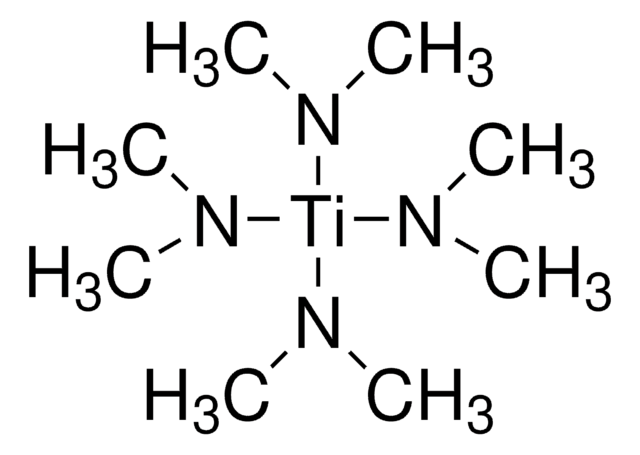669008
Tetrakis(dimethylamido)titanium(IV)
packaged for use in deposition systems
Synonym(s):
TDMAT, Tetrakis(dimethylamino)titanium(IV)
About This Item
Recommended Products
Assay
99.999% (trace metals analysis)
form
liquid
reaction suitability
core: titanium
bp
50 °C/0.5 mmHg (lit.)
density
0.947 g/mL at 25 °C (lit.)
SMILES string
CN(C)[Ti](N(C)C)(N(C)C)N(C)C
InChI
1S/4C2H6N.Ti/c4*1-3-2;/h4*1-2H3;/q4*-1;+4
InChI key
MNWRORMXBIWXCI-UHFFFAOYSA-N
Looking for similar products? Visit Product Comparison Guide
General description
Application
Signal Word
Danger
Hazard Statements
Precautionary Statements
Hazard Classifications
Flam. Liq. 2 - Skin Corr. 1B - Water-react 1
Supplementary Hazards
Storage Class Code
4.3 - Hazardous materials which set free flammable gases upon contact with water
WGK
WGK 3
Flash Point(F)
-22.0 °F - closed cup
Flash Point(C)
-30 °C - closed cup
Personal Protective Equipment
Choose from one of the most recent versions:
Already Own This Product?
Find documentation for the products that you have recently purchased in the Document Library.
Customers Also Viewed
Articles
Atomic Layer Deposition (ALD) is a coating technology that allows perfectly conformal deposition onto complex 3D surfaces. The reason for this uniform coating lies in the saturative chemisorption of sequential cycles of precursor vapors.
Nanocomposite Coatings with Tunable Properties Prepared by Atomic Layer Deposition
Since the demonstration of the first practical solar cell 60 years ago, research on novel materials, improved solar cell design and structure, and innovative manufacturing processes have all contributed to a continuous increase in the efficiency of photovoltaic (PV) devices.
Thin film photovoltaic devices have become increasingly important in efficiently harnessing solar energy to meet consumer demand.
Our team of scientists has experience in all areas of research including Life Science, Material Science, Chemical Synthesis, Chromatography, Analytical and many others.
Contact Technical Service








